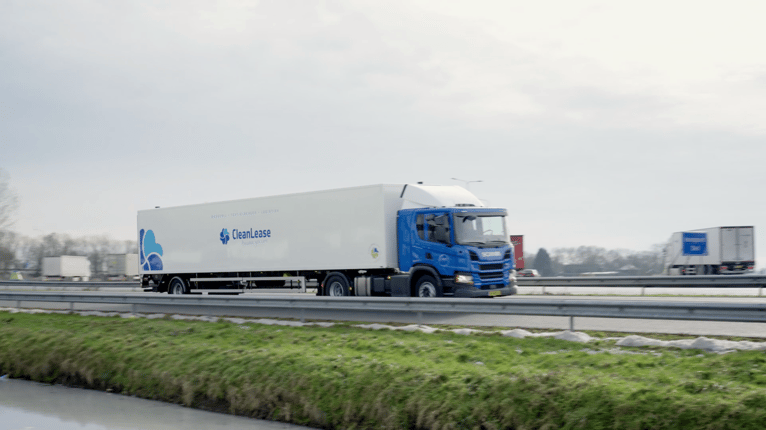CleanLease Improves the Sustainability of its Services with OptiFlow as a Tactical Routing Tool
Posted by Nathalie Göbel on Nov 24, 2022 3:37:15 PM

Textile cleaning company CleanLease, has a unique transport operation. The company has 27 locations in the Netherlands and Belgium, and almost ten times as many vehicles. Yet the company drives relatively few kilometers. “We aim to improve the sustainability of our services by choosing OptiFlow by Conundra as a tactical routing solution. After all, our customers primarily see our movement on the roads, as opposed to our laundry facilities. In addition, significant savings are made", says Arnoud Clement, project manager supply chain & transport.
The switch to OptiFlow enables CleanLease to take major steps in the field of logistics sustainability. By 2023, the company aims to reduce its CO2 emissions by 50 percent. CleanLease already carried out a baseline measurement in 2020, partially with regard to Lean and Green, a CO2 reduction program for shippers and logistics service providers. “As logistics accounts for 20% of our direct CO2 emissions, we are taking every possible step to reduce our carbon footprint.”
Finding the right tactical routing tool
CleanLease specializes in offering quality textile cleaning and rental services to hospitals, healthcare institutions, and holiday parks. Their business model relies on a recurring cycle that involves exchanging clean textiles for laundry, ensuring that the vehicles are never empty. The company prioritizes proximity to the customer, and with their 27 locations, they have successfully achieved this goal. "Each site functions as a laundry facility, varying in size with an average of 10 vehicles per location," notes Clement.
In 2021, prior to the implementation of OptiFlow, the routes were fixed, with predetermined delivery times within agreed-upon time windows. "Although this approach works well, it runs the risk of sticking to old habits. Recognizing that there were numerous opportunities to optimize efficiency, we sought a software package that would allow us to enhance our tactical transport planning.”
A supplier who proactively makes suggestions
Clement’s previous experience in the industry led him and his team to a number of potential suppliers. “We especially noticed differences in the user-friendliness of the applications, which was also proven in a number of practical tests. It eventually became clear that OptiFlow would be the most suitable solution for us. The fact that Conundra (now operating as PTV Logistics) provided valuable input and made various suggestions for achieving our desired optimization result definitely played a part in the choice we made.”
Testcase with our data
Clement highlights CleanLease's business case as "clear and unambiguous." He emphasizes that the best way to gain an accurate understanding of the potential of various software packages was to test them out himself. "To this end, we conducted a one-day trial using our own data at one of our locations, with several suppliers participating. The user-friendliness of the application and the diligent approach of Conundra stood out during the trial, and we still appreciate these qualities today."
From three routes to one
The switch to professional transport planning software meant that CleanLease said goodbye to planning with Excel and Google Maps. “This implementation marks a fresh start. When you input high-quality data into the system, you receive new and improved routes. For instance, where we previously operated three routes, OptiFlow suggested that we could condense them into one single route.”
New insights and greater savings than initially expected
While the roll-out of the new transport planning software is still ongoing across all locations, CleanLease is already seeing positive results. “We were doing pretty well with our existing tools, but now we know there are still a lot of efficiency gains to be realized at certain locations. In addition, when it comes to small volumes, extra optimization potential is unlocked by optimizing the capacity. Prior to the roll-out we expected an average improvement of about 5%, but in reality it is likely to be 10%, with peaks of up to 14%.”
Since not all branches have yet implemented OptiFlow, the software is mainly used for calculation purposes. "By slightly adjusting our customers' time windows, we can better utilize our vehicles, resulting in a more efficient plan with fewer kilometers," says Clement. The software performs all calculations, allowing planners to evaluate proposed routes and associated KPIs, making the planner's job even more essential.
‘A single adjustment impacts the rest of the chain’
According to Clement, there are certainly opportunities for improvement. "If we adjust the delivery time for customer A from 2 a.m. to 7 a.m., for instance, we can save on transportation costs. However, making even a single adjustment requires a lot of coordination within our supply chain. Our laundry facilities must have the textiles ready on time, so planning and production must align to ensure that the new routes are technically feasible. Additionally, the forwarding department must adjust their container-picking process. That's why we first perform all necessary calculations, consult with the customer, and then implement any changes to our transport planning accordingly."
Reoptimizing the tactical routing plan more often
CleanLease sees the investment as a way to drive their annual 7.5 million kilometers more efficiently, but also as a starting point for reorganizing all of their Dutch transport. Clement explains: “Determining in which direction we move with our transport is essential. Sustainability and alternative fuels will play a key role in this, and in 2025 we will be dealing with zero-emission zones at several locations. This sustainability pressure means that we have to make the right decisions today. With transport planning software OptiFlow we evaluate our choices in a tactical way, for now and in the future. We currently set our fixed routes once a year and reoptimize twice a year. I can imagine that we will be doing this more often in the future.”

